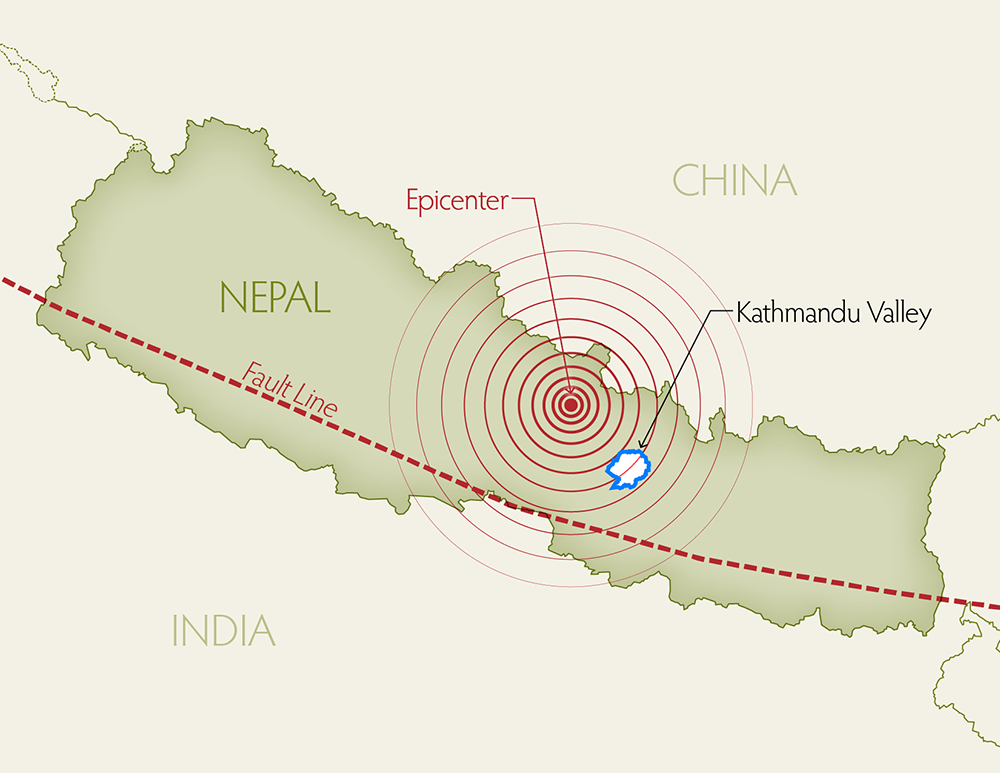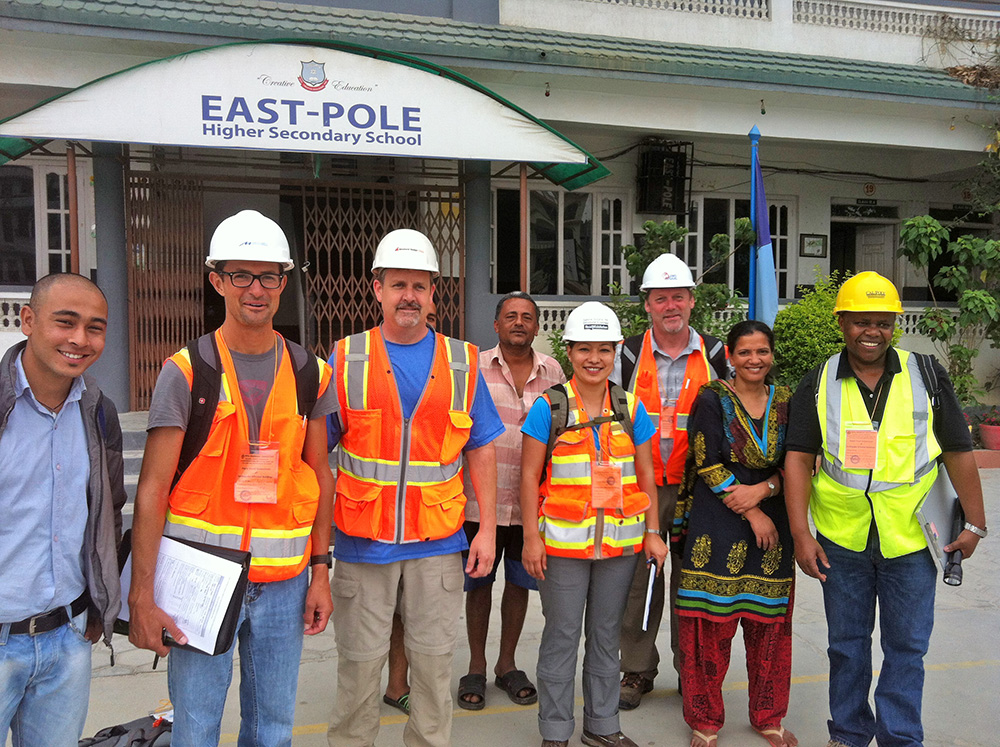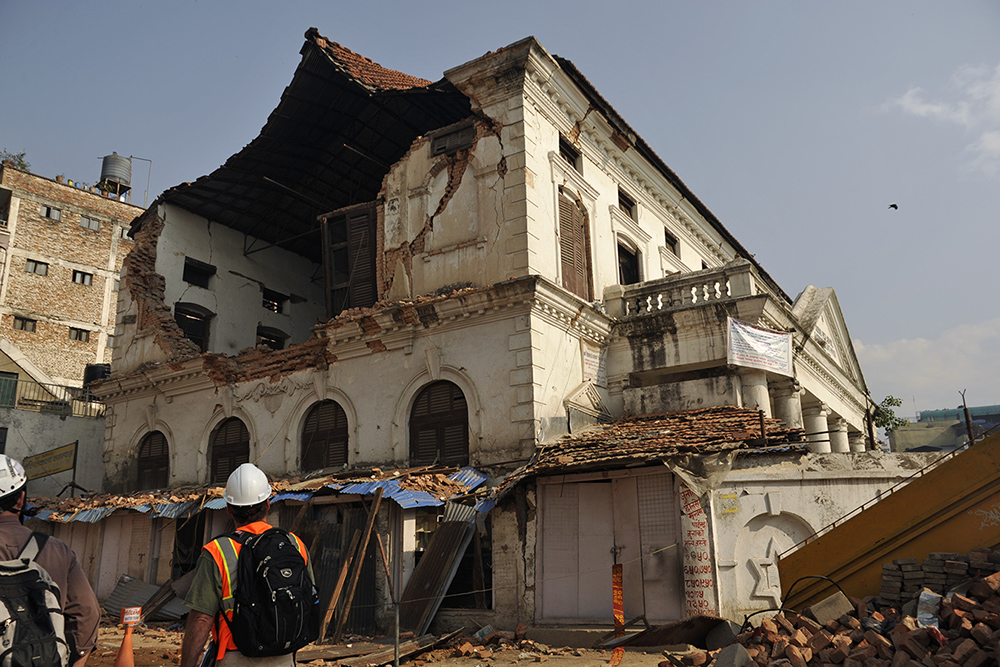I had the opportunity to participate in the disaster recovery effort in Nepal, following the devastating April 25, 2015 earthquake. I was selected as a volunteer with the first team of structural engineers deployed by Global Fairness Initiative (GFI). The primary mission of the team was to perform rapid assessments of damaged buildings in the Kathmandu Valley and to assist local authorities and residents in determining whether their structures were safe to occupy.

On May 12, while in transit at Philadelphia airport to board a flight to Doha, I had learned of another major aftershock of 7.3M in Nepal. The epicenter was about 47 miles east of Kathmandu. As the plane descended into Kathmandu International Airport, my heart raced – what destruction would I see from these two major earthquakes? I was relieved not to see much damage at the Kathmandu airport right when I got off the plane. Nonetheless, the reality is that these earthquakes have left lasting emotional devastation and fear on every single person in Nepal. Many people are still afraid of going back into their homes for fear that another aftershock may hit, even if their houses have only minor cracks. As monsoon season is soon approaching, the need to relocate local residents from the tents back into their homes was imminent. After 29 hours and 11,245 air miles of travel, I arrived at Kathmandu airport the evening of May 13. What follows is a travel log from my 10 days in Nepal.

May 14: Our first team meeting with GFI and its local partners, Brick Clean Nepal and MinEngy (a local engineering firm) was scheduled late morning. While waiting for the meeting and to get our assignments, I took a tour with my sister around the city, Patan. The devastation was hard to take in. I was born and raised in Nepal, so all of the fond memories growing up here collided with my emotions of seeing the devastation, and I found it difficult to reconcile my memories with the new reality before me. Being a native of Nepal, I can’t help but feel sentimental about the devastation; I am thankful for the safety of my family, friends and their neighbors. Countless others were not as fortunate. Many houses were severely damaged, and many had completely collapsed. Most of the houses that collapsed were old structures, built with brick and mud mortar. Later that day, I accompanied our team leaders to a meeting with government officials and heard their views on assessing and rebuilding the community.
May 15: Our team was tasked with performing safety assessments of the government complexes that currently house various ministries and government offices. The team then mobilized to provide safety assessments of residential dwellings. Based on our assessments, most of the reinforced concrete-framed with brick infill houses endured minimal damage on cement plaster or brick infill. The houses that performed poorly were either brick with mud mortar or were simply built poorly.
May 16: One of my teammates and I performed a safety assessment of buildings inside the compound of a private hospital. The main hospital was constructed of reinforced concrete frame with brick infill that had undergone several wing additions; it performed well. However, the dental clinic, constructed of load bearing brick masonry walls, experienced structural damage. Later that day, with a group of three other structural engineers from the U.S. and three Nepalese engineers, I also provided safety assessments to a private college and condominium complex. Toward the end of the day, the GFI director took us to one of the hard-hit areas called “Dharmasthali.” Seeing the large scale destruction there, we decided to return the following morning to continue our safety assessments of the structures that were still standing.
May 17: In the morning, three of my U.S. teammates and I performed a safety assessment of Durbar High School, one of the first high schools to provide modern education in Nepal. The building holding the high school was constructed in 1834 of brick and mud mortar. The high school itself opened in 1892. It was originally opened only for families of ruling aristocrats. Interestingly, the school now serves underprivileged students. Part of this building was rebuilt after damage caused by the 1934 earthquake. After the high school assessment, our team split up to go to different parts of Kathmandu. One of my U.S. teammates and I, along with an engineering student who provided translation, returned to Dharmasthali, where we had been the night before. Together, we provided safety assessments of more than 50 houses and the buildings inside the public school grounds in that area. Of the houses left standing, only a few were uninhabitable, yet most residents are living outside in tents out of fear their house will collapse like their neighbor’s. The houses that were completely destroyed were either adobe or brick with mud mortar, which accounted for approximately 50 percent of the houses in that area.
While there, I learned of many personal losses and tragedies that resulted from this earthquake. We were told that 20 people had lost their lives due to structural collapse. This is one of the areas I went where no matter how prepared I was emotionally, it still took a toll on me. At the end of that day, I was wiped out emotionally and physically. However, I felt a sense of relief and accomplishment that we helped many residents move back into their homes after assuaging their prior fears of their homes’ safety.
May 18: Our team of five provided safety assessments to a four-story private school. The principal of the school was excited to hear his building was safe to operate with only minor repairs. The most significant damage to this school was rooftop hot water heaters and water tanks support failures. After the assessment of the school, I performed an assessment of a private medical college complex with two other teammates.
May 19: We performed evaluations of Kathmandu School of Arts, Cinema Theater, Mary Ward School, and Kathmandu Forestry College. Later that evening, MinEngy hosted an informal meet and greet with our team at their office to discuss and share what we had seen.
May 20: One of my teammates, a local engineer, and I performed safety assessments of the buildings operated by Universal College. One of the new buildings under construction experienced massive structural damage, while some of the existing buildings performed well. Later that afternoon, we went to the residential area in Phutung to perform assessments. This is also one of the areas where almost half of the residences are of adobe construction and were not suitable to occupy.
May 21: We performed evaluations of a hospital, a residential building, a news publication building, and also participated in a press conference with a Nepalese newspaper.
May 22: The day after my commitment to volunteering with GFI was over, I was asked by one of the local structural engineers to accompany her to a remote village called “Bhattedanda.” She was travelling there with a team from Engineer’s Without Borders from Germany. The only access to that village was to drive uphill on a narrow dirt road and hike down to the villagers. The scenery down the hills is breathtakingly beautiful and serene, yet heartbreaking to see the local lives torn apart by the earthquake. All of the houses in this village were built with locally-available stone and mud mortar, with wood rafters and corrugated metal deck roofs. We learned from the locals that of the 110 houses in the village, more than 50 were completely collapsed.
May 23: I got to spend the whole day with my family before catching a flight back to Seattle that evening.
What follows is a slideshow of some of the structural damage I encountered in Nepal.

